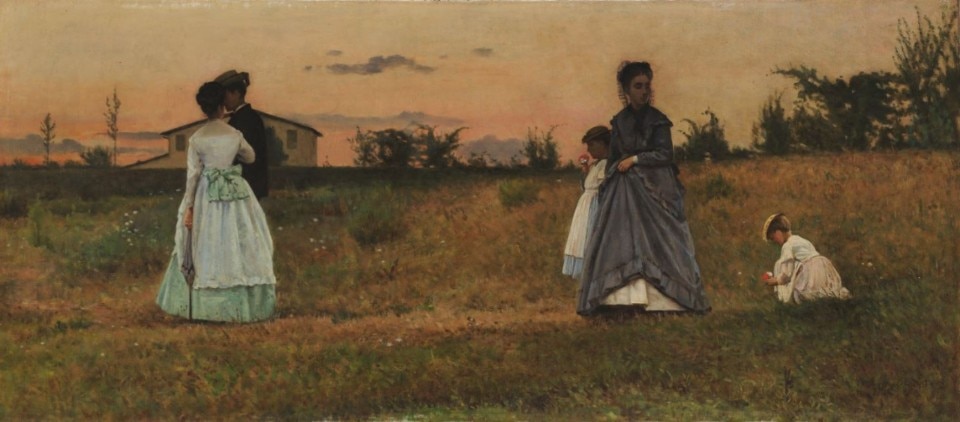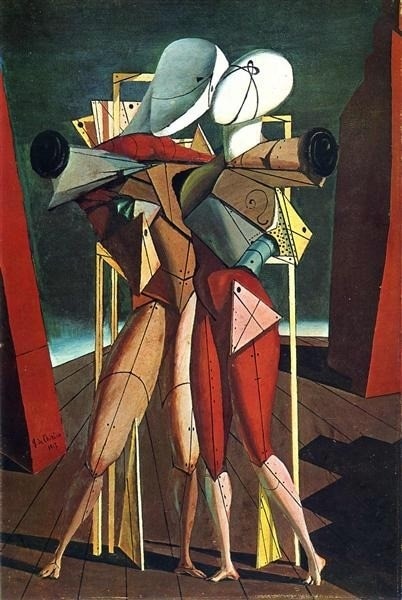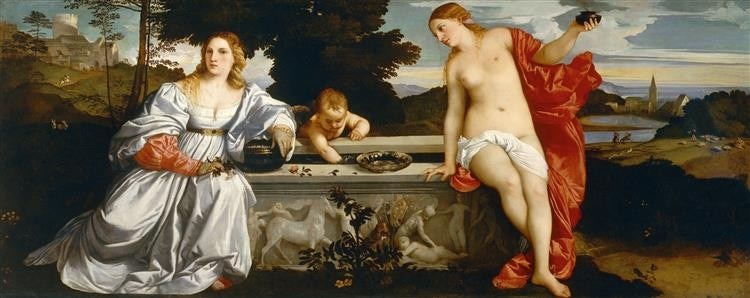“Love, which absolves no one beloved from loving,
seized me so strongly with his charm that,
as you see, it has not left me yet.”
Dante Alighieri, The Divine Comedy, Inferno, Canto V (tr. Hollander). Love.
For centuries, a great artistic heritage has been narrating love in every possible form and register. It has depicted scenes as well as symbolic and suggestive moments where looks, kisses, embraces, be they tender or erotic, are expressed through the classicism of Renaissance forms or in surrealist style, turning every detail into a symbol of expression and narration.
Two women sitting on the edge of an ancient sarcophagus narrate Tiziano Vecellio’s Sacred and Profane Love. They are very similar-looking, perhaps modelled on the same person to represent the two faces of marriage. Behind the woman on the right, who is dressed as a bride, are two white rabbits, the symbol of fecundity. In her hair, she is wearing myrtle leaves, a metaphor for marriage. A private love and a more sensual one, then, and the trough filled with water unites and mixes this love.

The painting suggests several readings where classical mythology shuffles the deck. Perhaps there’s Venus and Medea with a cupid behind them since in the bas-relief Venus is shown pricking her foot to save Adonis being attacked by Mars. On the opposite side there could be the Rape of Proserpina, not to mention the various philosophical readings where the ideas of Marsilio Ficino’s Academy identify the two young women as Earthly Venus and Heavenly Venus - carnal love and spiritual love.
I would want my love for her to be more than a feeling: a virtue
Love, always love, like the one Silvestro Lega stages in a small painting entitled I Fidanzati. The brushstrokes, typical of the Macchiaioli style, give substance to subtle characters, thus describing a simple scene. At sunset, a couple is walking, followed by a woman and a couple of children. This dynamic scene features a sequence dictated by the main characters, that is, the engaged couple. In this intimate and warm moment, the landscape follows the scene. The two are whispering something to each other, and right behind them is a house. Is it perhaps theirs? Or maybe is it the house the woman’s family? No one knows, but in any case, it is a symbol of their future, just like the group behind them, the woman with the children. Their task is to watch over the two, but could this also be an interpretation of the near future, of the life to come? Lega’s painting is simple, but it develops more contemporary reflections.

Giorgio De Chirico’s interpretation of love in his Hector and Andromache is also contemporary and metaphysical. The first-born son of Priam and Hecuba, known for being the most valiant of the “Trojan horse-tamers”, Hector is represented as a mannequin together with his beloved Andromache, one of the most touching epic figures. “Man battler”, this is the meaning of the name Andromache, a woman sentimentally defeated who saw her father Eëtion, king of Thebes, and her brothers descend into Hades. She is a woman who saw her beloved husband and her son Astyanax die, a woman destined to be deprived of male love in all its forms. Two mannequins then, two faceless figures representing the deprivation of life, the deprivation of feelings. In some way, De Chirico interprets Nietzsche’s thoughts, arguing the meaninglessness of life through art
Motionless and static, the two mannequins take on movement through the colours which, however, maintain an a-temporal dimension in a metaphysical non-place. Hector and Andromache embrace each other, although they have no arms. An embrace of comfort, of pain that seems to give form to Homer’s words: “So you, Hector, are father and mother and brother to me, as well as my beloved husband. Have pity on me now; stay here on the tower; and do not make your boy an orphan and your wife a widow...”
There are many more works of art on the subject of love, some of them better known, others more mysterious, and on the weekend before Valentine’s Day, we are paying a sentimental tribute to all these great artists. And to quote Curzio Malaparte, an extraordinary Tuscan writer: “I would want my love for her to be more than a feeling: a virtue”.
Opening image: Sacred and Profane Love, Tiziano Vecellio, 1514


